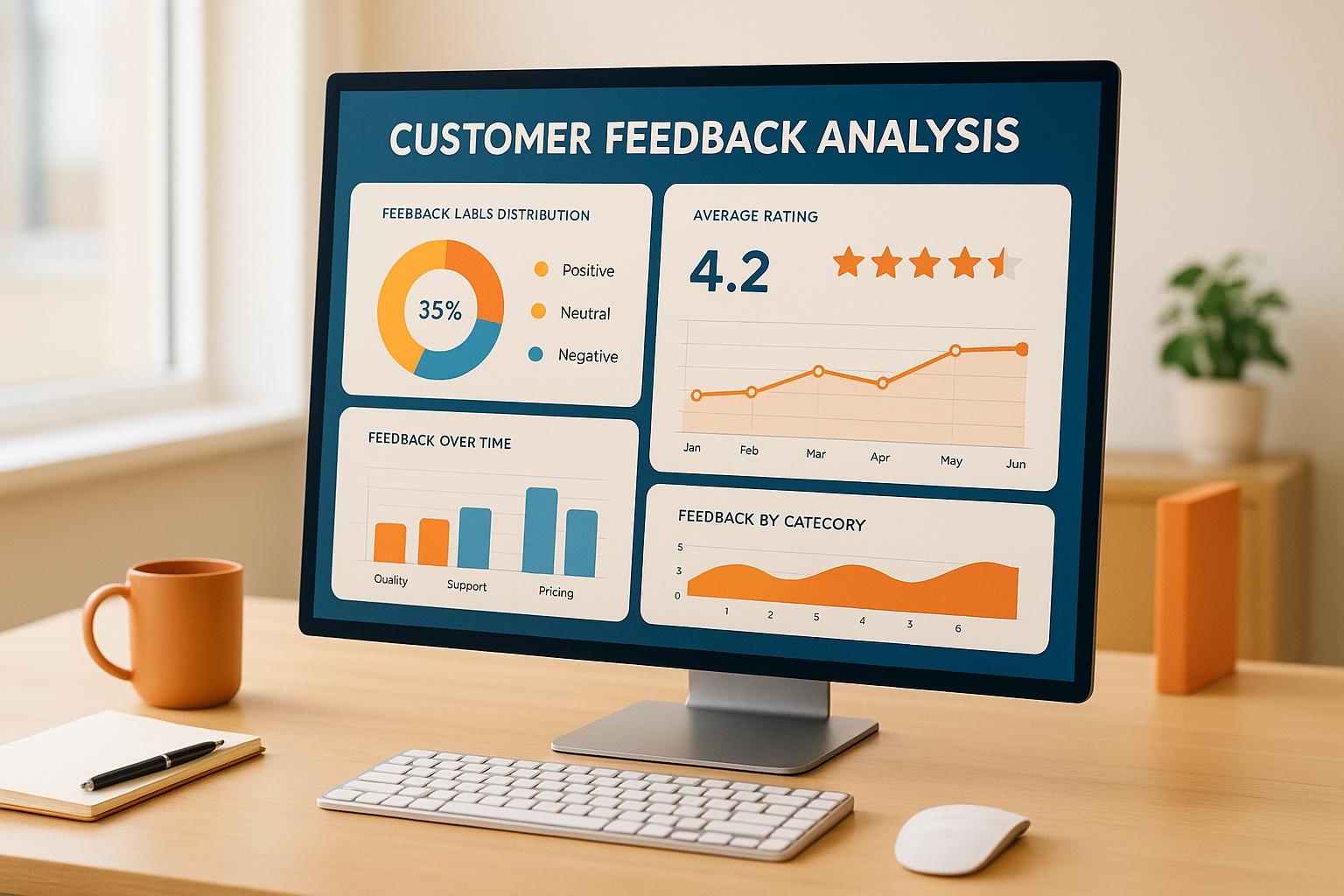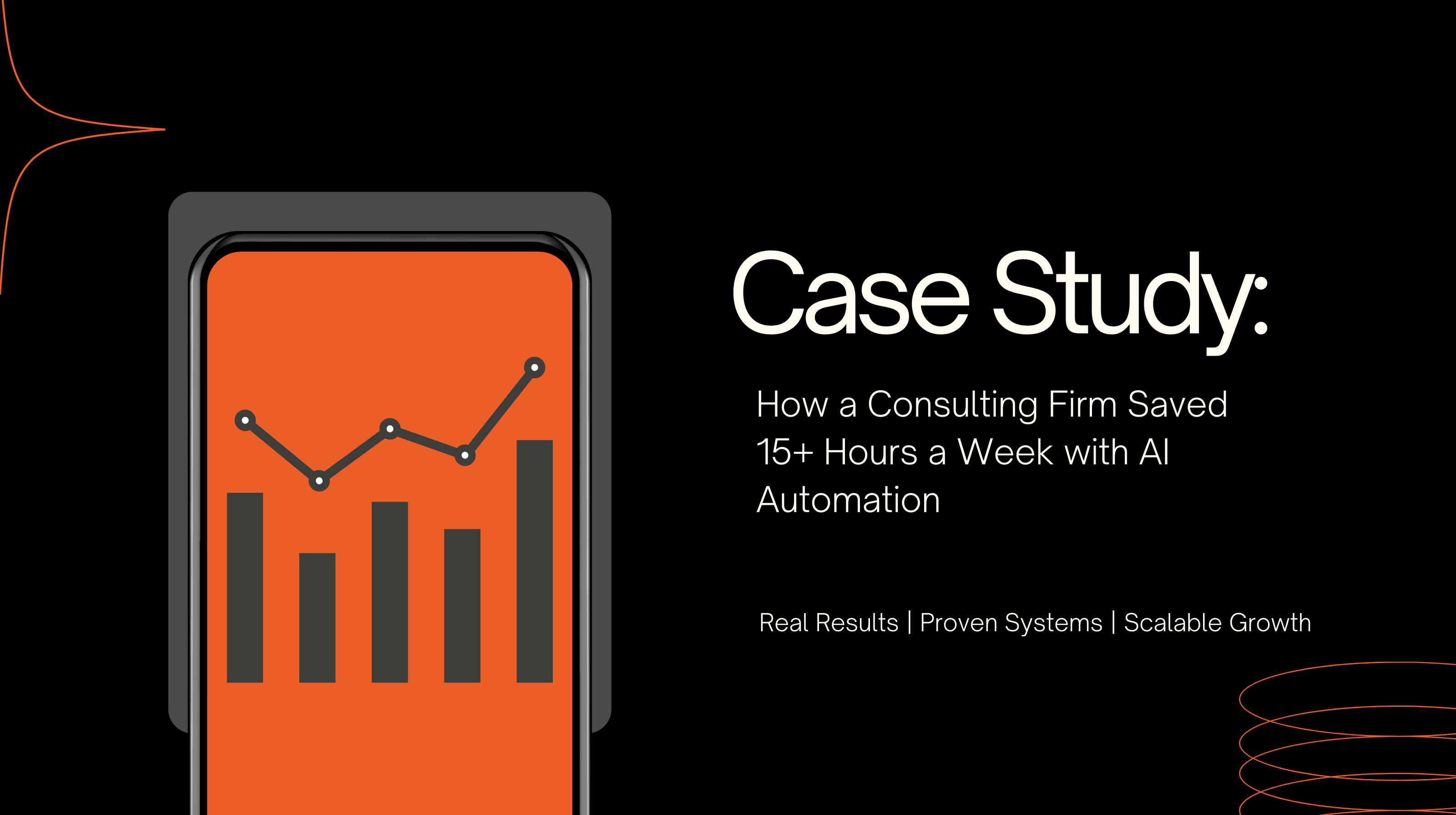AI is transforming how businesses handle customer feedback by analyzing vast amounts of data quickly and accurately. Here's what you need to know:
For example, companies like L'Oréal and Delta Airlines use AI to monitor customer sentiment, predict trends, and improve satisfaction rates. While AI speeds up processes, human oversight ensures the insights are correctly interpreted and applied.
Build This Product Feedback AI Analyst In Just 10 Minutes | FULL TUTORIAL
Collecting Customer Feedback with AI
AI simplifies the process of gathering customer feedback by consolidating it from various platforms into one system. This eliminates the need for manual tracking and ensures all data is organized for seamless integration into CRM systems, paving the way for informed, data-driven decisions.
Gathering Feedback from Multiple Channels
One of AI's strengths is its ability to pull feedback from multiple sources into a single, centralized hub. Instead of hopping between email inboxes, social media platforms, review sites, and survey tools, businesses can let AI handle the heavy lifting of collecting and organizing customer communications.
Using Natural Language Processing (NLP), AI interprets feedback from diverse sources, understanding meaning, detecting sentiment, and even deciphering casual language in social media comments, formal surveys, and detailed reviews.
Social media monitoring is a standout method for feedback collection. AI scans platforms around the clock for brand mentions, tracking both positive and negative conversations while spotting trends in customer sentiment. This real-time capability captures opinions that might otherwise go unnoticed in traditional feedback channels.
AI also excels in analyzing emails and support messages. It can automatically categorize and prioritize these communications, ensuring urgent issues are flagged for immediate action while routine feedback is systematically filed for analysis. By recognizing language patterns that signal frustration or satisfaction, businesses can respond more effectively.
Additionally, topic modeling helps organize feedback into key themes. Instead of manually sifting through endless comments, AI highlights recurring issues or praise, revealing what matters most to customers and pinpointing areas for improvement. This streamlined approach makes it easier to act on customer insights in real time.
Real-Time Feedback Collection with Automation
AI takes feedback collection a step further with real-time automation. For instance, 86% of marketers report that NLP tools save them at least an hour a day by streamlining tasks like feedback analysis. This efficiency extends to gathering customer opinions.
AI-powered chatbots are a prime example, seamlessly integrating into websites and apps to collect feedback during customer interactions. These bots make the process feel natural, capturing insights as they assist with problem-solving. Similarly, AI-driven survey tools adapt dynamically, tailoring questions based on customer responses. For instance, if a customer mentions dissatisfaction with shipping, the survey might dive deeper into delivery timing or packaging quality.
Brands like Love, Bonito use tools like Zendesk to automatically send CSAT surveys after customer support interactions. Meanwhile, Liberty, a luxury goods retailer, leverages Zendesk QA to evaluate customer interactions, achieving an impressive 88% CSAT score.
Looking ahead, 85% of customer service leaders are expected to pilot conversational generative AI for large-scale feedback collection by 2025. This shift underscores the growing preference for automated methods that deliver faster and more comprehensive insights than traditional approaches.
Data Privacy and Security Requirements
While automation improves feedback collection, safeguarding customer data is critical. With 57% of consumers worldwide expressing concern about AI's impact on privacy, businesses must prioritize robust data protection alongside innovation.
The financial stakes are high, too. The global average cost of a data breach hit $4.88 million in 2024. Samsung's 2023 ban on generative AI tools after engineers accidentally shared confidential code highlights the importance of strong data governance.
To address these challenges, companies need solid data governance policies that include data classification, strict access controls, and regular audits. Incorporating privacy considerations into the development of AI systems - known as "privacy by design" - ensures that security measures are built in from the start.
Transparency is another key element. In a climate where 70% of Americans distrust companies to make responsible AI decisions, clear privacy policies and user consent mechanisms are essential. They not only address consumer concerns but also demonstrate a commitment to ethical data handling.
"The most successful organizations will treat privacy not as a compliance burden but as a competitive advantage. By building AI systems that respect user choices, maintain transparency, and handle data responsibly, companies create the trust that's essential for long-term success." - Usercentrics
Privacy-enhancing technologies offer practical solutions for balancing compliance with AI capabilities. Techniques like differential privacy, federated learning, and synthetic data generation allow businesses to analyze customer feedback without compromising individual privacy. These methods focus on aggregate patterns, ensuring personal information stays secure.
Regular audits of privacy settings and careful consent management further ensure compliance. Businesses must also exercise caution when working with third-party AI platforms, as these may use customer data for model training.
As regulations evolve, companies that embed privacy safeguards into their operations will not only stay compliant but also build the trust needed for long-term success.
Processing and Analyzing Feedback with AI
Once feedback is collected, AI steps in to process the data up to 10 times faster than traditional manual methods, turning raw input into actionable insights. Here's a closer look at how AI simplifies and enhances feedback analysis.
Automated Data Tagging and Categorization
AI tagging removes the tedious task of manually sorting through a flood of customer comments by automatically organizing feedback into meaningful categories. With unstructured data growing three times faster than structured data, this automation is becoming a necessity for businesses aiming to stay on top of customer input.
"AI tagging automatically categorizes and applies relevant keywords and labels to data and content, making it easily discoverable and analyzable." – HeyMarvin
Using advanced text analysis, AI identifies patterns and themes in customer feedback, sorting qualitative data in real-time. This helps surface trends and insights that manual methods might overlook. For example, an e-commerce company used AI-powered auto-tagging to label product reviews based on attributes like durability, convenience, and satisfaction. This allowed for faster sorting and more focused responses.
AI systems excel at recognizing linguistic, logical, and mathematical profiles in text, matching feedback to predefined categories. Compared to manual methods, AI tagging is faster, more scalable, and more consistent.
To implement auto-tagging effectively, businesses should:
Once categorized, the next step is uncovering the emotions and sentiments behind the feedback.
Sentiment Analysis and Emotional Tone Detection
AI employs machine learning and natural language processing (NLP) to interpret context, detect emotions, and even recognize sarcasm. Advanced systems can perform aspect-based sentiment analysis, which evaluates specific features within feedback. For instance, a smartphone review might express positive sentiment about battery life but criticize the camera quality, rather than being labeled as neutral overall.
Major companies have successfully used AI for sentiment analysis:
AI systems continuously refine their ability to understand customer emotions by processing large datasets. Deep learning models even analyze subtle emotional cues, such as changes in pitch and rhythm in voice feedback.
Real-Time Insights and Summarization
By combining categorized data with sentiment analysis, AI delivers instant overviews to guide decision-making. In fact, 86% of marketers report that NLP tools save them at least one hour a day on creative tasks, showcasing the efficiency of automated analysis.
Real-time processing also helps businesses spot emerging issues before they escalate. Examples include:
AI-generated summaries integrate seamlessly into workflows, offering concise overviews that highlight key customer insights. These summaries allow businesses to pinpoint recurring problems and make proactive improvements to their products and services.
When combined, automated tagging, sentiment analysis, and real-time summarization create a powerful system for turning overwhelming customer feedback into clear, actionable insights. This approach enables businesses to act quickly, make informed decisions, and improve customer satisfaction on a large scale.
Using AI Insights for Business Decisions
Turning raw customer feedback into actionable insights is a game-changer for modern businesses. In fact, 67% of top-performing companies are using generative AI to improve their products, while 46% of executives focus on creating unique AI-powered solutions. These insights are shaping smarter, more informed business decisions by highlighting critical trends.
Finding Trends and Patterns in Feedback
AI thrives in analyzing massive datasets, uncovering patterns that manual reviews often overlook. For example, Verizon used AI to analyze millions of customer interactions, which helped them resolve issues more efficiently. Similarly, Netflix leverages AI to recommend content and guide production decisions. AI-powered tools can spot recurring issues - like long wait times - shedding light on customer frustrations and enabling proactive solutions. These insights reveal connections within customer experiences that traditional methods might miss entirely.
Making Data-Driven Business Decisions
Once these patterns emerge, they can drive precise actions to enhance customer satisfaction and boost revenue. AI analytics identify market trends, pinpoint pain points, and uncover growth opportunities. For instance, Starbucks uses its Deep Brew tool to tailor marketing, manage inventory, and even suggest products based on factors like location and weather. Similarly, Clean & Restore used AI to analyze feedback, uncovering scheduling issues that they resolved - leading to a 25% drop in complaints within just three months.
"AI-powered analysis of customer feedback and comments can help identify trends in customer behavior and allow e-commerce businesses to adjust their strategies and marketing accordingly, in order to improve customer satisfaction." – Dharmendra Singh, PIIT College
These insights don’t just solve problems - they help businesses anticipate customer needs and refine their services. For companies seeking a deeper dive into AI-driven feedback analysis, custom solutions can streamline operations and deliver measurable growth. Firms like Devcore specialize in creating tailored AI systems designed to meet specific business objectives.
The Need for Human Oversight
Even with advanced AI, human oversight remains critical. While AI can process data at incredible speeds, it often misses the full context and nuance behind customer sentiment. Humans are essential for interpreting the "why" behind the data and adding a personal touch. Matthew Franzyshen, Business Development Manager at Ascendant, emphasizes that human review is necessary to avoid misinterpreting subtle language. Combining AI's efficiency with human expertise ensures that insights lead to actionable strategies that align with broader business objectives.
This partnership between AI and human judgment creates a feedback system that’s both scalable and strategically effective.
Overcoming AI Implementation Challenges
While AI holds immense promise, its implementation isn't without hurdles. These challenges can disrupt automation efforts and lead to costly delays. By identifying these obstacles early and crafting clear strategies, businesses can navigate the complexities of AI deployment more effectively.
Common AI Feedback Analysis Challenges
One major roadblock is legacy system integration. A staggering 63% of enterprises report delays in AI projects due to outdated systems, with 41% facing cost increases of 30-50% when trying to bridge these gaps. These older systems simply weren't built to handle the demands of modern AI, creating technical bottlenecks and driving up expenses.
Another critical issue is data quality. Fragmented or outdated feedback data can severely impact the accuracy of AI models. This becomes especially problematic when organizations attempt to analyze feedback from multiple sources without proper data standardization.
A lack of strategic vision also derails many AI initiatives. Research shows that 58% of failed AI projects in customer service result from unclear success metrics and poor collaboration across departments. Without defined goals and measurable outcomes, it's easy for AI solutions to miss the mark.
Security and privacy concerns add another layer of complexity. Handling sensitive customer data through automated systems requires robust safeguards, yet 34% of businesses admit they lack AI-specific security policies. This leaves them vulnerable to data breaches and compliance risks.
Lastly, organizational resistance can slow adoption. Employees often worry that AI will replace their roles, leading to pushback. In fact, 47% of customer service teams reported reduced productivity during AI rollouts due to poor change management. Additionally, 62% of companies struggle with skill gaps in areas like prompt engineering and AI monitoring, highlighting the need for targeted training.
Balancing Automation with Human Review
Addressing these challenges requires a thoughtful balance between automation and human oversight. Businesses that combine AI with human input have seen customer satisfaction scores improve by 22% compared to fully automated systems. This approach leverages AI's efficiency while retaining the empathy and judgment that only humans can provide.
The key is to determine which tasks can be fully automated - such as sentiment scoring or basic categorization - and which require human interpretation. Complex issues involving emotional nuances or strategic decisions still benefit from human involvement.
For instance, a hybrid model that pairs automated sentiment analysis with human review ensures accuracy and responsiveness. Dashboards that track accuracy rates, flag unusual trends, and alert human reviewers when confidence levels drop can help maintain high standards.
From the customer's perspective, maintaining human touchpoints is crucial. Studies show that 67% of customers would abandon a brand after two negative AI chatbot interactions. This underscores the importance of blending automation with human support for sensitive or complex issues.
"AI honestly admitted that it requires human supervision and direction to operate effectively." - ChatGPT
Employee training programs can ease the transition to AI-augmented workflows. By focusing on upskilling rather than replacement, businesses can reduce resistance and build the expertise needed for effective AI management.
Solutions for Implementation Challenges
Here’s how businesses can tackle common AI implementation obstacles:
Starting small with pilot programs can also reduce risks. Testing AI systems on limited datasets allows businesses to fine-tune their approach before scaling up. This phased strategy provides valuable insights and minimizes disruptions.
For organizations looking for expert guidance, partnering with firms like Devcore can streamline the process. These specialists design custom AI solutions tailored to specific business needs, ensuring smooth integration and measurable outcomes.
Ultimately, overcoming these challenges requires careful planning, realistic goals, and a focus on delivering tangible business results - not just adopting the latest technology for its own sake.
The Future of AI in Customer Feedback Analysis
Customer feedback analysis is undergoing a transformation, with the AI sentiment analysis market and broader sentiment analysis software sector poised for strong growth through 2025 and beyond.
AI-driven feedback tools are evolving rapidly, moving beyond basic sentiment detection. These advanced systems are becoming more adept at analyzing not just the what behind customer interactions but also the why. By examining emotions, preferences, and behaviors, they enable businesses to foster deeper engagement and loyalty. The technology now incorporates multimodal analysis, which evaluates text, voice, facial expressions, and behavioral patterns simultaneously to gain a richer understanding of customer emotions.
Breakthroughs like real-time emotion mapping and predictive sentiment modeling are changing the game. For instance, 80% of companies using emotion mapping technology report improvements in customer satisfaction, and 60% see notable reductions in customer complaints. These tools help businesses anticipate shifts in customer sentiment, create emotional journey maps, and intervene proactively when needed. When paired with personalized sentiment baselines, which establish individual customer profiles, AI can spot deviations from normal patterns and trigger automatic responses.
"Sentiment analysis remains a dynamic research and application area with promising advances." - Expert from Kayako
However, these advancements bring heightened responsibility around data privacy and security. As customer data becomes more valuable, organizations must prioritize ethical practices and robust security measures. Customer consent will play a pivotal role, ensuring that businesses respect privacy while leveraging AI insights. The potential costs of data breaches further underscore the need for vigilance.
Key Takeaways
AI-powered automation is reshaping customer feedback analysis, offering benefits far beyond what traditional manual methods can achieve. One of the standout advantages is scalability - AI systems can analyze 100% of customer interactions across agents, bots, BPOs, and languages. This comprehensive approach ensures no valuable feedback is overlooked, giving businesses a full view of customer sentiment.
Real-time processing capabilities allow organizations to stay ahead of shifting customer attitudes. AI can identify trends and patterns in massive volumes of feedback - something that would be impossible for human analysts to achieve on their own. Additionally, AI excels at complex tasks like designing survey questions and extracting insights from survey data, further enhancing its usefulness.
Accuracy is another major strength, with AI-powered sentiment analysis achieving an 85% accuracy rate using neural networks. This level of precision, combined with the ability to process vast amounts of data continuously, empowers businesses to make better, data-driven decisions across all customer-facing functions.
Importantly, AI doesn’t replace the human element - it complements it. 77% of customers are more likely to choose a brand that understands and addresses their needs. AI provides the insights necessary to meet those needs at scale, enabling businesses to deliver a more personalized and responsive customer experience. These capabilities also integrate seamlessly with existing CRM platforms, paving the way for tailored solutions.
Custom AI Solutions for Business Needs
While pre-built AI tools offer valuable features, many businesses find that custom AI solutions deliver better results by addressing their unique needs and challenges. Customer feedback today spans multiple channels, languages, and contexts, often requiring tailored approaches that generic tools can’t provide.
Custom AI systems can be designed to fit seamlessly into existing CRM platforms, incorporate industry-specific language, and align with unique business processes. This level of customization ensures that the AI doesn’t just interpret what customers are saying but also understands the context within your specific market.
For businesses ready to fully leverage AI in customer feedback analysis, Devcore offers expertise in building custom AI and automation systems. Their proprietary Leverage Blueprint™ maps operational challenges and designs AI solutions that integrate smoothly into workflows, delivering measurable outcomes.
The future of customer feedback analysis lies in not just adopting AI, but implementing it strategically to gain a competitive edge. As Sir David Brailsford, Leader of Team Sky, once said: "Clear feedback is fundamental to improvement." Custom AI solutions ensure that feedback becomes a driving force for continuous growth and customer satisfaction.
FAQs
How does AI improve the accuracy of sentiment analysis in customer feedback?
AI improves the precision of sentiment analysis by learning from human-verified data. This ongoing learning process helps it better identify and reduce mistakes, such as false positives or negatives. Additionally, it employs multimodal analysis, which integrates text, tone, and context to provide a deeper and more accurate interpretation of customer feedback.
By handling vast amounts of data swiftly and consistently, AI offers a dependable way to gauge customer sentiment. This allows businesses to respond more effectively and enhance the overall customer experience.
What data privacy practices should businesses follow when using AI to analyze customer feedback?
When using AI for feedback analysis, safeguarding customer data should be a top priority. Businesses can achieve this by focusing on data encryption to secure sensitive information, enforcing strict access controls to limit who can view or handle the data, and performing regular security audits to identify and fix vulnerabilities. It's equally important to clearly explain how customer data is being used and to obtain explicit consent before proceeding. Lastly, adhering to privacy regulations such as GDPR and CCPA is crucial not only for maintaining customer trust but also for staying on the right side of the law.
How can businesses use AI alongside human expertise to enhance customer feedback analysis?
Businesses can take their customer feedback analysis to the next level by blending AI automation with human expertise. AI tools shine when it comes to handling massive amounts of data, spotting patterns, and conducting sentiment analysis with speed and precision. But here's the thing - human judgment plays a key role in understanding context, dealing with delicate matters, and making ethical calls.
By letting AI handle repetitive tasks and heavy data crunching while relying on humans for deeper insights, companies can strike a balance that boosts efficiency, accuracy, and trust. This combination of technology and human input not only speeds up the process but also adds a personal touch, enabling organizations to truly grasp and respond to what their customers need.
Related posts
- Manual Workflows Slowing Growth? AI Solutions
- Using AI to Prevent Customer Churn
- Ultimate Guide to Custom AI Cost-Benefit Analysis
- How AI Enhances Real-Time Workflow Reporting
{"@context":"https://schema.org","@type":"FAQPage","mainEntity":[{"@type":"Question","name":"How does AI improve the accuracy of sentiment analysis in customer feedback?","acceptedAnswer":{"@type":"Answer","text":"<p>AI improves the precision of sentiment analysis by learning from human-verified data. This ongoing learning process helps it better identify and reduce mistakes, such as false positives or negatives. Additionally, it employs <strong>multimodal analysis</strong>, which integrates text, tone, and context to provide a deeper and more accurate interpretation of customer feedback.</p> <p>By handling vast amounts of data swiftly and consistently, AI offers a dependable way to gauge customer sentiment. This allows businesses to respond more effectively and enhance the overall customer experience.</p>"}},{"@type":"Question","name":"What data privacy practices should businesses follow when using AI to analyze customer feedback?","acceptedAnswer":{"@type":"Answer","text":"<p>When using AI for feedback analysis, safeguarding customer data should be a top priority. Businesses can achieve this by focusing on <strong>data encryption</strong> to secure sensitive information, enforcing <strong>strict access controls</strong> to limit who can view or handle the data, and performing <strong>regular security audits</strong> to identify and fix vulnerabilities. It's equally important to clearly explain how customer data is being used and to obtain <strong>explicit consent</strong> before proceeding. Lastly, adhering to privacy regulations such as <strong>GDPR</strong> and <strong>CCPA</strong> is crucial not only for maintaining customer trust but also for staying on the right side of the law.</p>"}},{"@type":"Question","name":"How can businesses use AI alongside human expertise to enhance customer feedback analysis?","acceptedAnswer":{"@type":"Answer","text":"<p>Businesses can take their customer feedback analysis to the next level by blending <strong>AI automation</strong> with <strong>human expertise</strong>. AI tools shine when it comes to handling massive amounts of data, spotting patterns, and conducting sentiment analysis with speed and precision. But here's the thing - human judgment plays a key role in understanding context, dealing with delicate matters, and making ethical calls.</p> <p>By letting AI handle repetitive tasks and heavy data crunching while relying on humans for deeper insights, companies can strike a balance that boosts efficiency, accuracy, and trust. This combination of technology and human input not only speeds up the process but also adds a personal touch, enabling organizations to truly grasp and respond to what their customers need.</p>"}}]}




